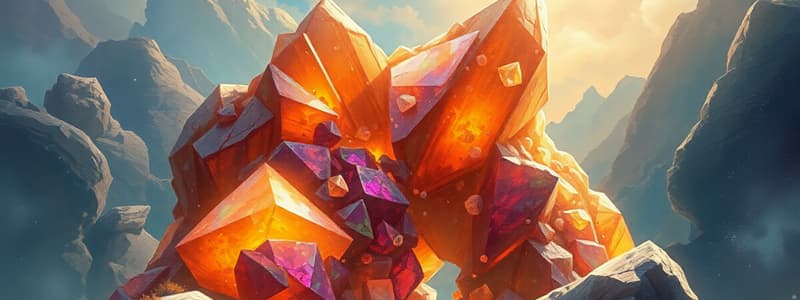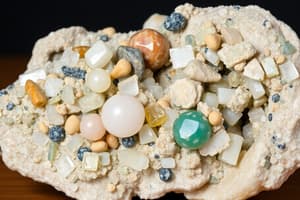Podcast
Questions and Answers
All minerals have the same color.
All minerals have the same color.
False (B)
The way a mineral reflects light is called luster.
The way a mineral reflects light is called luster.
True (A)
Cleavage refers to the way a mineral feels when touched.
Cleavage refers to the way a mineral feels when touched.
False (B)
A mineral with metallic luster looks shiny like a metal.
A mineral with metallic luster looks shiny like a metal.
Streak is always the same color as the mineral.
Streak is always the same color as the mineral.
What is the difference between cleavage and fracture in minerals?
What is the difference between cleavage and fracture in minerals?
Name two tools you can use to test a mineral's hardness.
Name two tools you can use to test a mineral's hardness.
Why is color alone not a reliable property for identifying minerals?
Why is color alone not a reliable property for identifying minerals?
What property is tested by rubbing a mineral on a porcelain tile?
What property is tested by rubbing a mineral on a porcelain tile?
Name three physical properties you can use to identify a mineral.
Name three physical properties you can use to identify a mineral.
Flashcards
Luster: What's a mineral's shine like?
Luster: What's a mineral's shine like?
A characteristic of a mineral that describes how it reflects light. Examples include metallic, glassy, or dull.
Hardness: How scratch-resistant is a mineral?
Hardness: How scratch-resistant is a mineral?
A mineral's ability to resist scratching. It's measured using the Mohs Hardness Scale.
Streak: What color is the mineral's powder?
Streak: What color is the mineral's powder?
The color of a mineral's powder when rubbed against a streak plate.
Cleavage & Fracture: How does a mineral break?
Cleavage & Fracture: How does a mineral break?
Signup and view all the flashcards
Mineral Identification: How do you tell minerals apart?
Mineral Identification: How do you tell minerals apart?
Signup and view all the flashcards
Mohs Hardness Scale: How hard are minerals compared?
Mohs Hardness Scale: How hard are minerals compared?
Signup and view all the flashcards
Toughness: Can a mineral bend or snap?
Toughness: Can a mineral bend or snap?
Signup and view all the flashcards
Crystal Structure: Like an internal building blueprint
Crystal Structure: Like an internal building blueprint
Signup and view all the flashcards
Crystal Habit: What's the mineral's natural shape?
Crystal Habit: What's the mineral's natural shape?
Signup and view all the flashcards
Tenacity: How easily does a mineral bend, stretch, or tear?
Tenacity: How easily does a mineral bend, stretch, or tear?
Signup and view all the flashcards
Cleavage: How does a mineral break neatly?
Cleavage: How does a mineral break neatly?
Signup and view all the flashcards
Cleavage vs. Fracture: Neat break vs. uneven break
Cleavage vs. Fracture: Neat break vs. uneven break
Signup and view all the flashcards
Tools for Hardness Testing: How do we test a mineral's scratch resistance?
Tools for Hardness Testing: How do we test a mineral's scratch resistance?
Signup and view all the flashcards
Color: Is it a reliable mineral ID?
Color: Is it a reliable mineral ID?
Signup and view all the flashcards
Streak Test: Rubbing a mineral for a color clue
Streak Test: Rubbing a mineral for a color clue
Signup and view all the flashcards
3 Mineral Identification Properties: Clues for finding a mineral's identity
3 Mineral Identification Properties: Clues for finding a mineral's identity
Signup and view all the flashcards
Luster: How does a mineral reflect light?
Luster: How does a mineral reflect light?
Signup and view all the flashcards
Hardness: How scratch-resistant is a mineral?
Hardness: How scratch-resistant is a mineral?
Signup and view all the flashcards
Streak: What color is the mineral's powder?
Streak: What color is the mineral's powder?
Signup and view all the flashcards
Cleavage & Fracture: How does a mineral break?
Cleavage & Fracture: How does a mineral break?
Signup and view all the flashcards
Mineralogy: What's the science of rocks and crystals?
Mineralogy: What's the science of rocks and crystals?
Signup and view all the flashcards
Mineral: A natural solid with a specific composition and structure.
Mineral: A natural solid with a specific composition and structure.
Signup and view all the flashcards
Mineral Identification: How do you tell minerals apart?
Mineral Identification: How do you tell minerals apart?
Signup and view all the flashcards
Mohs Hardness Scale: A scale to compare mineral hardness.
Mohs Hardness Scale: A scale to compare mineral hardness.
Signup and view all the flashcards
Toughness: How strong is a mineral?
Toughness: How strong is a mineral?
Signup and view all the flashcards
Crystal Structure: How a mineral's atoms are arranged.
Crystal Structure: How a mineral's atoms are arranged.
Signup and view all the flashcards
Crystal Habit: A mineral's natural shape
Crystal Habit: A mineral's natural shape
Signup and view all the flashcards
Tenacity: How does a mineral bend or tear?
Tenacity: How does a mineral bend or tear?
Signup and view all the flashcards
Cleavage: How does a mineral break cleanly?
Cleavage: How does a mineral break cleanly?
Signup and view all the flashcards
Cleavage vs. Fracture: Smooth break vs uneven break
Cleavage vs. Fracture: Smooth break vs uneven break
Signup and view all the flashcards
Tools for Hardness Testing: How do we test a mineral's scratch resistance?
Tools for Hardness Testing: How do we test a mineral's scratch resistance?
Signup and view all the flashcards
Color: A tricky clue in mineral ID
Color: A tricky clue in mineral ID
Signup and view all the flashcards
Streak Test: Rubbing a mineral for a color clue
Streak Test: Rubbing a mineral for a color clue
Signup and view all the flashcards
3 Mineral Identification Properties: Identifying a mineral's identity
3 Mineral Identification Properties: Identifying a mineral's identity
Signup and view all the flashcards
Study Notes
Physical Properties of Minerals
- Minerals have various physical properties used to identify them
- Hardness: Measured using the Mohs scale
- Luster: Describes how a mineral reflects light
- Streak: Color of a mineral's powdered form
- Cleavage: How a mineral breaks along flat surfaces
- Fracture: How a mineral breaks in an irregular way
- Color: Not always a reliable indicator due to impurities
Identifying Minerals
- Multiple properties are often needed to identify a mineral, not just color
- Rubbing a mineral on a porcelain tile tests its streak
- Hardness is measured using the Mohs scale
- Luster describes how the mineral reflects light
- Cleavage describes how the mineral breaks
- Fracture describes how the mineral does not break in a plane
Studying That Suits You
Use AI to generate personalized quizzes and flashcards to suit your learning preferences.




